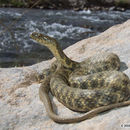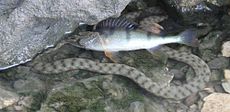en
names in breadcrumbs


In Egypt appears to be largely crepuscular or nocturnal, but also seen active during the day. Almost entirely aquatic.
Least Concern
A medium to large, slender snake. Largest Egyptian specimen has a total length of 900 mm. Tail relatively short, tail / total length = 0.17-0.18; nostril large, round, in a divided nasal; 1 loreal, 8 supralabials, fourth enters the eye, 160-197 ventrals, 48-86 paired subcaudals, dorsals strongly keeled, 19 scale rows around mid-body, anal divided. Dorsum dark green-olive, with a pattern of regularly spaced black spots; a black chevron on the nape. Venter yellow, variably chequered with black squares, or is sometimes almost completely black.
Throughout the Nile Delta and lower Nile Valley, also Fayoum and the Suez Canal zone. Anderson (1898), Flower (1933), and Marx (1968) all recorded the species solely from the northern parts of the Delta. However, it appears that since the construction of the High Dam (late 1960s) and as a result of subsequent ecological changes (establishment of extensive swamp vegetation fringing the Nile River), the species seems to have spread southward, along with other wetland wildlife previously also confined to the northern Delta wetlands, most notably the Purple Gallinule {Porphiryo porphiryo: Aves). A specimen reported by Barbour (1914) from "Fuweila in Sinai," is actually a locality in Jordan (Hoofien 1965).
Central Europe east to western China, south to Egypt and possibly Yemen.
Freshwater wetlands of all kinds, rivers, canals, swamps, and lake shores. Particularly common in waterways fringed with dense reeds and other swamp vegetation.
Common and widespread. Large numbers are collected by animal traders.
Diced snakes live in the Delta of the Danube River in Romania (1).
The dice snake (Natrix tessellata) is a Eurasian nonvenomous snake belonging to the family Colubridae, subfamily Natricinae. It is also called water snake.[3]

Females are bigger than males. Their typical size is 1.0–1.3 m (39–51 in) long. Their color may vary from greyish green to brownish or almost black, with dark spots on the back. The belly is sometimes vividly coloured in yellow or orange, with black spots, very similar to dice, hence the name.
Living mainly near rivers, streams and lakes, it frequently feeds on fish. Sometimes, it feeds also on amphibians such as frogs, toads, and tadpoles.
Classified as nonvenomous, N. tessellata produces a potent antihemorrhagin in its serum[4] and has been said to produce a neurotoxin through a gland in its mouth.[5] As a defence, it spreads a very bad-smelling secretion from its cloaca. Another defence mechanism is thanatosis, playing dead.
During the mating season (March–May), they congregate in large groups. Egg-laying is usually in July, and one clutch consists of 10–30 eggs. The young snakes hatch in early September.
Dice snakes hibernate from October to April in dry holes near the water.
The dice snake is found throughout much of Eurasia: Afghanistan, Albania, Armenia, Austria, Azerbaijan, Bosnia and Herzegovina, Bulgaria, China, Croatia, Cyprus, Czech Republic, France, Georgia, Germany, Greece, Hungary, India, Iran, Iraq, Israel, Italy, Jordan, Kazakhstan, Kyrgyzstan, Lebanon, Montenegro, North Macedonia, Pakistan, Poland,[6] Romania, Russia, Serbia, Slovakia, Slovenia, Switzerland, Syria, Tajikistan, Turkmenistan, Turkey, Ukraine, Uzbekistan, and Yemen. The species is also present in Egypt.
One of the most numerous populations lives in the vicinity of the ruins of Histria, in the Dobruja region, Romania. This population has been recently discovered to be threatened by a parasitic nematode of the genus Eustrongylides. Since 2005, the population from Histria has been receiving researchers' attention. For example, a joint Romanian–Swedish–Czech research program is focused on population biology studies and parasitic threats of this unique coastal population. An overview on Biology, Distribution and Conservation is given by Mebert (2011).[7]
 Natrix tessellata
Natrix tessellata The dice snake (Natrix tessellata) is a Eurasian nonvenomous snake belonging to the family Colubridae, subfamily Natricinae. It is also called water snake.